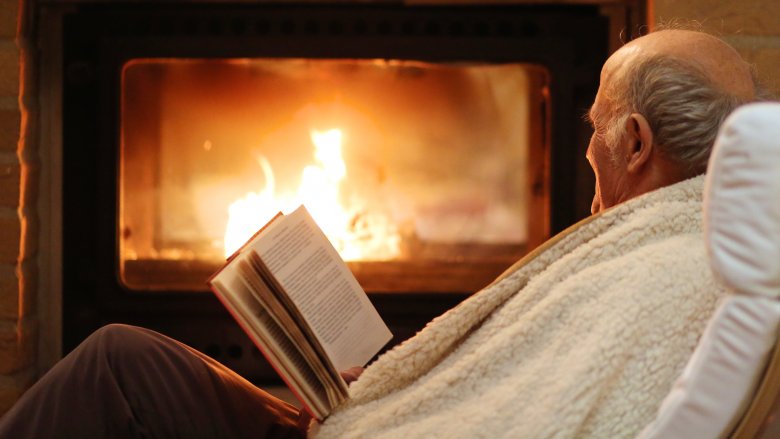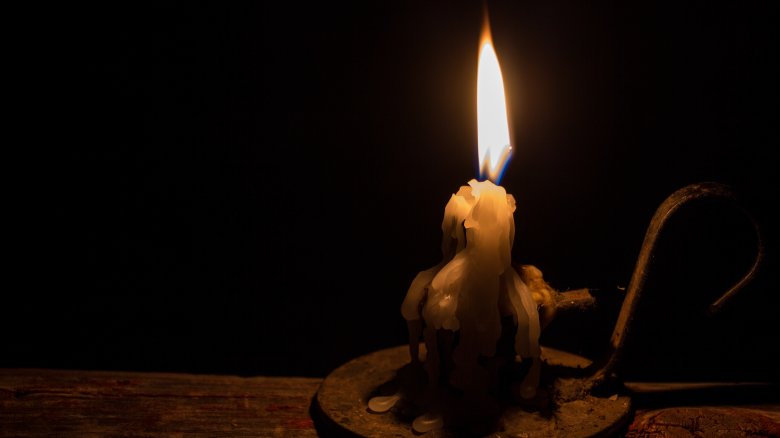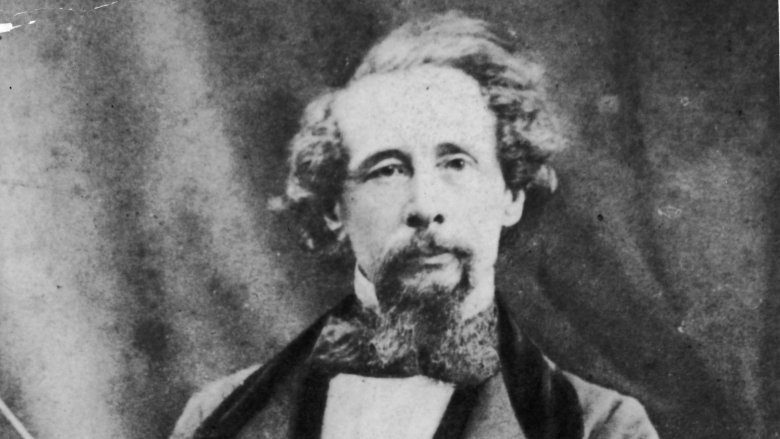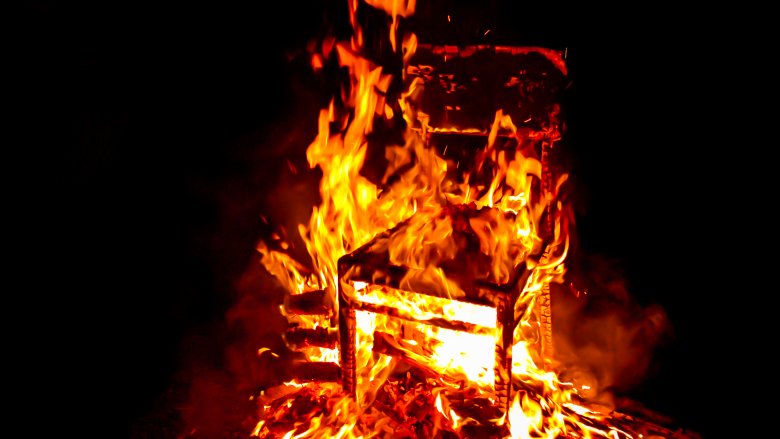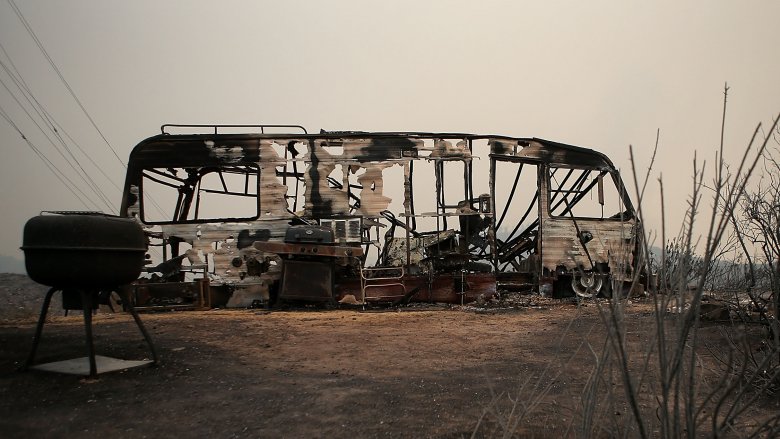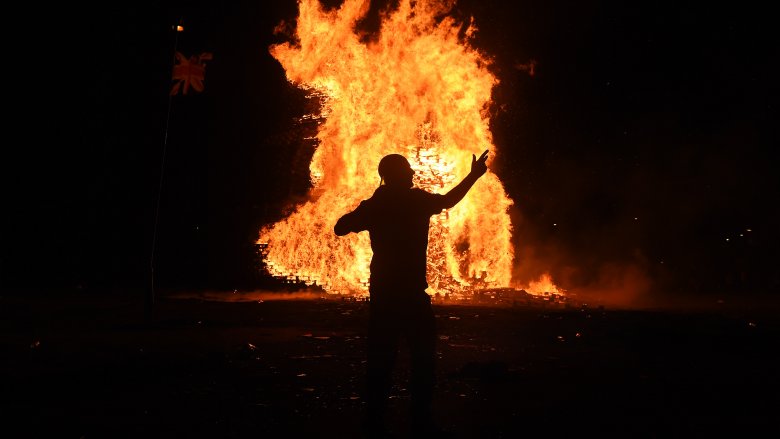The Mystery Of Spontaneous Human Combustion
You know the story: A perfectly normal person retires to bed for the evening. While they sleep, they catch on fire and burn to ash. In the aftermath, the authorities can't find any discernible source of the blaze. Even stranger, the objects around the victim — aside from maybe their clothes, or the chair they were dozing in — are perfectly fine.
For years, spontaneous human combustion (or SHC, for those in the know) has baffled scientists and amateur paranormal investigators alike. But how mysterious is SHC, really? Like any other paranormal phenomenon, there are a number of logical explanations for spontaneous human combustion. Whether or not you believe them, on the other hand, is entirely up to you.
A long-lived tradition
If you think that people unexpectedly bursting into flames is a modern phenomenon, think again. The earliest recorded report of spontaneous human combustion dates all the way back to the Late Middle Ages. In 1470, an Italian knight named Polonus Vorstius decided to kick back and relax with a couple of glasses of wine. Unfortunately for Polonus, the chill-session didn't quite go according to plan. First, he started burping fire. Next, Polonus burst into flames and burned to a crisp in front of his poor, traumatized parents.
That's how the story goes, anyway. Officially, Polonus Vorstius' fiery fate didn't enter the historical record until 1641 — nearly two centuries after Polonus' demise. That's when a Danish medical expert named Thomas Bartholin included the event in his magnum opus, the Historiarum Anatomicarum Rariorum, which catalogs strange medical cases from throughout history. Bartholin claimed that he heard the story from later generations of the Vorstius family, but with 200 years between the alleged immolation and Bartholin's written account, it's entirely likely that the story had been embellished by the time that Bartholin got to it. At the very least, like every other case of spontaneous human combustion, the Vorstius blaze is more or less impossible to verify.
Official symptoms
Much of the mystery surrounding spontaneous human combustion comes from the fact that, quite simply, it takes a lot of energy to burn a body. According to body burning-experts, it takes somewhere between 1400 and 1800 degrees Fahrenheit to cremate a human being — far, far more heat than a match, candle, or cigarette is capable of. And yet, according to both a study cited by the British Medical Journal and a more recent survey from the Journal of Clinical Forensic Medicine, suspected cases of spontaneous human combustion reduce the victim's body to ash (although, occasionally, the deceased's hands and feet survive). Even stranger, the victims' surroundings in these cases are largely unharmed, even if they consist of flammable materials, which seems counter-intuitive given how intense the necessary fires must be.
There are other similarities between SHC cases, too. Alleged spontaneous human combustion victims tend to be elderly, are primarily female, and are often overweight and alcoholic. Their ashes are greasy and emit "very offensive" odors. And then, of course, there's the real kicker: most of the time, nobody actually sees the victims catch on fire, and there's never been a credible witness to verify that spontaneous human combustion took place.
The human candle explanation
While spontaneous human combustion might be a compelling answer to these mysteries, there's actually a widely accepted theory that explains away almost every irregularity. It's a phenomenon called the "the wick effect," and it's both a compelling explanation for most cases of suspected SHC and very, very gross.
According to the theory of the wick effect, the human body acts sort of like a candle, with the person's clothes (or some other draping, like a blanket) serving as a wick. As the clothing burns — ignited by, say, a stray cinder from a nearby fireplace, or the ash from a cigarette — it splits the skin and melts the victim's body fat. The fat then soaks into the fabric and becomes another, constantly renewing source of fuel that keeps the fire going and creates extra heat. If you've ever had a grease fire in your kitchen, it's basically like that, except with a human body at the center instead of deep-fried stuffed peppers.
In experiments done with pig flesh (which is close to a human's), fires that start this way tend to burn straight up, singing the ceiling, and also progress fairly slowly, leaving the most of the surroundings intact. This also explains the greasy residue that the fires leave behind — it's liquefied body fat. That also explains why the largely fat-free hands and feet tend to survive these fires, why SHC tends to affect the overweight, and why the source of the fire is often unidentified. At such extreme temperatures, whatever started the blaze is incinerated right alongside the body.
Or maybe it's something weirder
The wick effect explains most spontaneous human combustion cases, but not all of them. And, as with anything that's possibly paranormal, there are a number of alternate theories out there.
Some are semi-reasonable. Researcher Brian J. Ford argues that ketosis, a condition in which a glucose-starved body starts feeding on fat, increases the body's acetone levels. Acetone is flammable, and so ketosis — which is a common symptom of both alcoholism and low-carb diets — makes the person more likely to catch on fire. Meanwhile, a rare drug allergy called Stevens-Johnson Syndrome leaves blisters on its victims that look a lot like burns, although it doesn't exactly reduce a body to ash.
Other theories aren't so reasonable. At least one scientist thinks that ball lightning, a largely unexplained scientific phenomenon, might cause SHC. Some paranormal researchers think that SHC might be related to poltergeists, who are often blamed for setting non-sentient objects on fire. In his 1995 book Ablaze!, author Larry E. Arnold — who, as critics note, doesn't actually have any scientific training — hypothesizes that there are subatomic particles called "pyrotrons" in the human body that, when agitated by stress, make people more likely to burst into flame.
That's pretty unlikely. But hey, at least "pyrotron" sounds pretty cool.
A literary concern
Whether or not spontaneous human combustion is real — and the evidence certainly seems to suggest that it isn't — it became a major source of worry for readers in the 1800s thanks to a very unlikely source: Charles Dickens.
In the December 1852 installment of his serialized novel Bleak House, author Charles Dickens dispatched of the alcoholic landlord Mr. Krook via a conveniently-timed case of spontaneous combustion. As in most instances of SHC, Krook's body was reduced to ash, while his junk-filled apartment made it through the fire unscathed, save for some grease on the windows and a putrid smell. (The stack of papers in Krook's cluttered abode would ultimately and conveniently solve Bleak House's main conflict, a legal case called Jarndyce and Jarndyce.)
At the time, the public considered the scientifically-minded Dickens a "realistic" author, and when he used SHC as a plot device, most readers assumed that it was just as real as Dickens' other subjects, which included smallpox, sleep apnea, and tuberculosis. Some scholars, including Dickens' close friend George Lewes, didn't swallow the story quite as easily. Lewes attacked Dickens in a public newspaper, claiming that Bleak House gave "credence to a scientific impossibility." Dickens shot back by citing numerous examples of apparent spontaneous human combustion from throughout history and by citing recent scientific discoveries — including oxygen, which is crucial for both the body and fires — to make his case.
Rise to flame
Arguably the most famous modern case of spontaneous human combustion occurred in 1951, when a 67-year-old widow named Mary Reeser died in an unknown and mysterious fire in her St. Petersburg, Florida apartment.
The Reeser case has all of the hallmarks of spontaneous human combustion. According to the original newspaper article about Reeser's death, Reeser was a "robust" woman (the St. Petersburg Times lists her weight at 170 pounds) who burned to ash along with the armchair that she was sitting in. Only her foot remained. The ceiling and upper walls of Reeser's apartment were covered in soot, but the furniture and lower walls were perfectly fine. Detective Cass Burgess, who investigated Reeser's death, claimed that there were no signs of common accelerants like ether, kerosene, or napalm at the crime scene. The mysterious fire propelled the city of St. Petersburg into the national spotlight, and attracted the attention of amateur sleuths all over the country.
But there's also a perfectly logical explanation for Reeser's demise. In 2009, reporter Jerry Blizin, who covered the Reeser story in 1951, revisited one of his most famous cases, now armed with some additional details. The FBI concluded that Reeser's own body fat fueled the fire. The night that she died, Reeser told her son that she'd skipped dinner in favor of two sleeping tablets. He last saw her sitting in the armchair where she later died, smoking a cigarette. While nobody will ever know exactly what happened to Ms. Reeser, there's an obvious conclusion — and there's nothing supernatural about it.
Getting away with murder
Spontaneous human combustion may not be real, but it does have real-life consequences — including, in at least one case, keeping a suspected murderer out of jail.
According to a Doctor's Review article, The Nicole Millet case first appeared in French author Jonas Dupont's tome De Incendiis Corporis Humani Spontaneis, one of the first pieces of known literature about spontaneous human combustion. As the story goes, an innkeeper named Jean Millet went to bed one evening in 1725, while his wife — a notorious drunk — stayed in the kitchen, claiming she couldn't sleep. At around two in the morning, a strange smell woke Millet up. He rushed downstairs and discovered his wife's charred remains scattered across the kitchen. Allegedly, only her skull and and a few other bones remained. The floor underneath the woman burned away, but nearby objects, including a straw bed and a wooden tub, were fine.
Millet was tried and convicted of murder and given a death sentence, but a physician named Claude-Nicolas Le Cat intervened. Le Cat, who had been staying at Millet's inn when Nicole met her fiery fate, convinced the court that Nicole spontaneously combusted. The court changed Nicole's cause of death to "Act of God" and let MIllet go — not that it did him much good. As forensic medicine expert Theodric Romeyn Beck noted, the murder conviction ruined Millet's reputation and his health, and he died shortly thereafter.
Fuel for the political fire
If you haven't noticed by now, alcohol plays a big role in spontaneous human combustion. It's not hard to see why. Not only does booze make you clumsy, which makes you much more likely to mishandle that cigarette, lighter, or matchstick, but too much alcohol makes a person fall asleep or, in extreme cases, fall unconscious.
In fact, the link between drinking and supposed cases of spontaneous human combustion was so well documented that, in the 18th and 19th century, doctors and scientists considered alcohol to be one of the primary causes of SHC. According to the so-called experts, alcohol transformed into flammable gas inside the body, which led to certain people catching aflame. In 1799, a physician even listed which spirits were most likely to cause SHC: gin was the worst, followed by brandy, whiskey, and finally, rum.
Bad science or not, the public association between alcohol and SHC provided a boon to the moral crusaders who led the temperance movement. Throughout the 1800s, prohibitionists used anecdotal accounts of spontaneous combustion in their anti-alcohol screeds. Claiming that the easiest way to avoid exploding is to simply stop drinking is a pretty compelling argument, after all. Spontaneous human combustion became one of the main arguments for temperance arguments until roughly 1928.
The Sole Survivor
Aside from the fires, there's one trait that every case of spontaneous human combustion has in common: they're all fatal. That changed in 1974, when a travelling salesman named Jack Angel claimed that he spontaneously combusted one night — and actually survived to tell the tale.
As reported by Larry E. Arnold (the pyrotron guy) in Ablaze!, Angel woke up one morning with a burn on his hand so bad that he needed an amputation. In addition, he found a hole in his chest and various burns scattered across his groin, back, and legs. His clothes, however, were unaffected, as was his motor home. According to Arnold, Angel said that a doctor told him that the fire started "internally," and claimed to be the only person in history to survive SHC.
But was he really? Joe Nickell, author of Real-Life X-Files: Investigating the Paranormal doesn't think so — and if anyone would know, it's Nickell. As one of America's only professional paranormal researchers, a senior research fellow at the Committee for Skeptical Inquiry, and a self-described skeptic, Nickell helped expose hoaxes like the infamous Patterson Bigfoot tape, a forged diary that supposedly revealed Jack the Ripper's identity, and the popular television personality and alleged psychic John Edward.
Nickell says that, before Angel claimed to be a SHC survivor, he went to court with a very different story. After the water pressure in Angel's motor home went out, Angel began tinkering with the water heater, which resulted in a torrent of hot water and led to the burns. According to Nickell, Angel tried to sue the RV manufacturer, but the case was dismissed in federal court. Only then did the SHC story begin to circulate.
A modern problem
Don't be fooled: while the history of spontaneous human combustion is filled with hearsay, superstition, and pseudoscience, it still crops up in the modern age. A BBC article reports that in 2010, Michael Faherty, a 76-year-old man, died at home in West Galway, Ireland. According to reports, he was burned to a crisp. The floor below and the ceiling above were also damaged. The rest of the house was fine. While the forensic investigators determined that Faherty's fireplace was lit, they said that the furnace wasn't the cause of the fire. You probably know where this is going.
Dr. Ciaran McLoughlin, the coroner who handled Faherty's case, was baffled. He consulted medical texts. He talked to experts, and performed other types of research. He didn't find any answers. Left with a blank death certificate, McLoughlin only had one choice. "This fire was thoroughly investigated," McLoughlin said, "and I'm left with the conclusion that this fits into the category of spontaneous human combustion, for which there is no adequate explanation."
Did Faherty really die of spontaneous human combustion, or was McLoughlin simply out of options? We'll leave it to you to decide.

